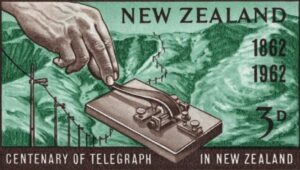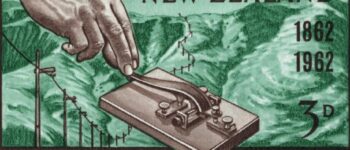1862: First Telegraph
July 1, 2022
By AHNZ

Today in history, 1 July, 1862, Canterbury politicians congratulated themselves on New Zealand’s first telegraph line. They held a special public dinner, a ball, and then another dinner. As this postage stamp (image, left) commemorates, the line ran over the Port Hills from Christchurch to Lyttelton.
It wasn’t long before Central Government started re-writing history and legislation to claim the fame and the power of the new Information Technology for itself. As Bill Brittenden wrote for the Press, this was as much stolen valor and proprietary conceit as if central government’s NZ Rail Ministry were to retroactively declare Ferrymead Railway their creation too. The truth is that Cantabrians build New Zealand’s first telegraph line (and first railway line too, at Ferrymead.)
Anarchists have seen time and again that The State thrives on giving itself credit for things it was barely involved with or actively impeded. Despite their self-congratulations and lavish dinners and telegraph balls the history in this case is no different. The real suffering genius who stuck his neck out to bring the telegraph to this country was rebuked and rejected and humiliated by government and so, for the better part of 5 years, was his dream project.
“…the neat little plaque which now adorns the east wall of the Chief Post Office in Cathedral square: it was unveiled on a day quite without significance in the history of telegraphy in New Zealand; it should surely be on the Provincial Council Buildings in Armagh street; the inscription, discreetly vague about the date, refers to the “first Government telegraph” in New Zealand. In the absence of any reference to the Provincial Government’s initiative in this matter, the stranger will assume that the telegraph was inaugurated by the central Government whence, we are encouraged to believe, all blessings flow. Will we, in December next year, find another plaque placed on the Railway Station implying that the Ferrymead railway is a child of the New Zealand Railways Department? This complaint is not parochial; it comes from a desire to see credit given where it is due and historical accuracy maintained as far as possible.” – Bill Brittenden, Press (1962,) Papers Past
” There was not only a dinner to celebrate the opening of the line to the public on July 1; a ball was held in the Town Hall, Lyttelton, on August 6 to “celebrate the telegraph.” Tickets admitting one gentleman and two ladies cost 10s 6d and the music was supplied by the “celebrated German Band.” A Second Dinner These celebrations might have seined adequate, but Ollivier arranged a second dinner at Christchurch on July 17 because of the unavoidable absence from the first of Moorhouse and other dignitaries, “who were bound for Wellington to attend the sitings of the General Assembly” – ibid
“Can you send out lightnings, that they may go, And say to you, ‘Here we are!’?” – Job 38:35
“Telegraph sang a song about the world outside, Telegraph Road got so deep and so wide. Like a rolling river” – Dire Straits
 In fact, the expert and all the materials to create this first telegraph had not been welcomed and embraced at all. Edmund Green (image, right) was encouraged to come to Canterbury to use his expert knowledge to build this telegraph line in 1859. All the lines equipment sat around the Provincial Council yard gathering moss and Green was treated no better. Happy to fight about taking the credit when the work was done, the government actually rejected Green and humiliated him by assigning him manual labour. Disenfranchised, impoverished, the Green family had to find a way to survive in this colonial outpost barely 10 year on from it having been an uninhabited swamp plain.
In fact, the expert and all the materials to create this first telegraph had not been welcomed and embraced at all. Edmund Green (image, right) was encouraged to come to Canterbury to use his expert knowledge to build this telegraph line in 1859. All the lines equipment sat around the Provincial Council yard gathering moss and Green was treated no better. Happy to fight about taking the credit when the work was done, the government actually rejected Green and humiliated him by assigning him manual labour. Disenfranchised, impoverished, the Green family had to find a way to survive in this colonial outpost barely 10 year on from it having been an uninhabited swamp plain.
Green had been put up to the job by our dear old ADHD Canterbury Founding Father James Fitzgerald. Fitz set the whole thing up while back ‘home’ in England taking for granted that his fellow Canterbury Pilgrims would carry out his telegram vision. However, in the absence of Fitz it was his political adversary William Moorhouse who was the power now. No scheme belonging to one political faction is ever adopted by another so Green, poor pawn, had to wait until 1862 for the political climate to change so that his ship could come in. He would go on to make many more telegraph lines for New Zealand including the first trans-Tasman line to Sydney.
Fitzgerald, having returned to Canterbury, became a great beneficiary of the new line. He founded the Press newspaper to help him take on his political rivals who were empowered by the Lyttleton Times. It was now possible to run a paper from Christchurch with parity of information with Lyttleton thanks to the instantaneous electronic communication Green had built. Another reason the project was able to go ahead may have been the “Complicated Iron Posts” Brittenden tells us about. There is no technical reason for for complicated iron posts and the technicians in fact declined to use them over the hills in favor of more practical wooden ones. The Anarchist assumption is that someone in government had a shady side-scam to write these iron posts into the contract to raise a bit of re-election cash without which their support would not have been given in Council.
“Mr. Edmund Green, was the first telegraph expert to reach New Zealand, having been sent from London by James Edward FitzGerald, agent for Canterbury, to supervise the erection of the line between Christchurch and Lyttelton. On reaching Lyttelton in 1859, Mr. Green was informed that Mr. FitzGerald had acted prematurely in sending him out, as there was no money available for the work. The polls, wire, insulators and instruments ordered by Mr. FitzGerald were duly shipped to Lyttelton, and lay idle for years, until the Government decided to pierce the hill and connect* the two settlements by rail. Mr. Edmund Green was thrown on his own resources, but after making a living as best he could for himself and his wife and young family,..”- HISTORY OF TELEGRAPHS FIRST EXPERT IN DOMINION, NZ Herald (1935;) Papers Past
“It was a set-back he was not prepared for and he soon was on his beam-ends. However, with crocodile tears, the Government took compassion on his wife and five children, so they gave him a job as carpenter at seven bob a day. This was humiliating to a man who had never soiled his hands at hard work, though he had always worked hard with his head. However, he had to bottle his pride (as others had to do) or starve. He started on his seven bob a day and as time went on he was told to go into the saw-pit to work a very heavy saw.” – Star (1925,) Papers Past
Green’s local area network was actually ready and working on 17 June, 1862, but everyone had to wait a few weeks for the official politically ordained opening date recorded in government history books.
Green lived out the rest of his days a New Zealander yet State history doesn’t have much to say about him. History has been made murky by the forgotten drive by government to take credit for itself which leaves Green behind in obscurity. Fortunately the Green family learned the lesson of trusting their fortunes to The State and took matters of remembrance into their own hands. Thanks to the family there are great clock towers at New Brighton and Sumner dedicated to Edmund Green our telegraph man.
—
Image ref. 1962 postage stamp remembering 100 years since NZ’s first telegraph, NZ Postal Department, Colnect.com
Image ref. Edmund Green, Star (1925,) Papers Past; Colorised by AHNZ
Ref. NEW ZEALAND’S FIRST TELEGRAPH LINE – 1ST JULY 1862, DISCO
 Like Comment Share
Like Comment Share





